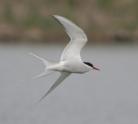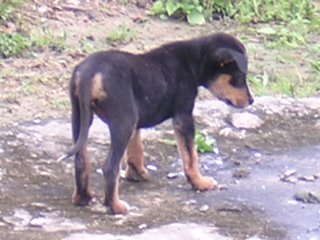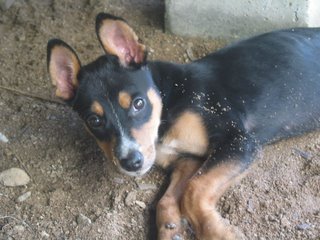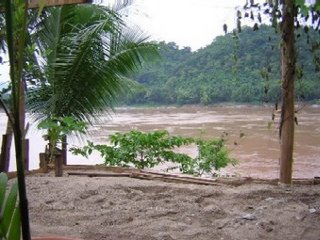A note on the pictures: My traveling companions and I do not appear in any of these – a desire for anonymity and privacy prevent me from posting our images. Of course, I feel no compulsion to protect the identities and privacy of the Laotians, Thais and other Westerners I took pictures of… double-standard in full operation here. Whenever possible, however, I did ask and receive permission before taking pictures. And my apologies for the writing – not my best – but I am just eager to get this post up!
I am not starting at the beginning, but rather near the end of the beginning, before the middle, with my side trip into Laos. A short trip – two or three nights I think. To put things into order – my flight path took me from San Francisco to Taipei (for a 4-hour layover) then to Thailand’s capital, Bangkok (an hour’s layover) and then north to Chiang Mai, the second largest city in Thailand and where my friends have a townhouse. Spent a few days in Chiang Mai and at my friends' farm (about a two hour drive from Chiang Mai and outside the village Fong). We returned to Chiang Mai to catch a propeller plane northwest to Luang Prabang. The plane was filled with an array of Western, Chinese, and Thai tourists.
to Thailand’s capital, Bangkok (an hour’s layover) and then north to Chiang Mai, the second largest city in Thailand and where my friends have a townhouse. Spent a few days in Chiang Mai and at my friends' farm (about a two hour drive from Chiang Mai and outside the village Fong). We returned to Chiang Mai to catch a propeller plane northwest to Luang Prabang. The plane was filled with an array of Western, Chinese, and Thai tourists.
Although Vientiane (south of Luang Prabang) is the capital of Laos, we chose Luang Prabang because it is as of yet less-developed than Vientiane and happens to be a UN World Heritage site. Laos, a third-world (the layers of meaning for that word are patently absurd), developing nation (another term that implies other nations are already developed - but does that mean we can stop developing?) is actively establishing an eco or green tourist industry, and Luang Prabang is a big piece of that effort.
But what the heck does that really mean? It means the natural environment as well as the traditional lifestyles of the people are the tourist attraction. That’s why tourists come. Theoretically, green tourism will help local people keep their way of life, yet prosper. And it will help preserve the natural beauty and resources of the land. I should add that some of the local activities (weaving, making saa paper, etc.) have been developed into a cottage industry not just to support green tourism, but as an alternative to the poppy-growing business. Laos has worked aggressively to reduce the number of hectares of opium fields. They claim to have eliminated all the fields.
Some concerns arise with green or eco tourism - one of which is planned development and Luang Prabang may well struggle with that. There is no parking available in the town – not really. Tourists can take vans and other conveyances from the airport into the main part of town. I prefer this – it would be great to keep traffic to a minimum in this town. But at some point, as one of my traveling companions remarked, the local merchants, hotel owners and managers, and restaurateurs will begin to prosper and purchase cars – and there is no place for them in the town. What will be removed to make way for parking lots and how will that affect the local community? Or will the town develop an efficient and green-friendly public transportation system for the locals? And how will that system affect the town and its tourist industry?
 Our guesthouse in Luang Prabang was lovely. No phone in the room and a short walk from the main hotel lobby; it offered an enticing view of the Mekong River (more on the Mekong later). The French once colonized Laos, so the architecture is somewhat French Provencal, or to me, a bit reminiscent of the French Quarter in New Orleans (though I’ve not yet been to “Nawlins” – seen pics though).
Our guesthouse in Luang Prabang was lovely. No phone in the room and a short walk from the main hotel lobby; it offered an enticing view of the Mekong River (more on the Mekong later). The French once colonized Laos, so the architecture is somewhat French Provencal, or to me, a bit reminiscent of the French Quarter in New Orleans (though I’ve not yet been to “Nawlins” – seen pics though).

Above is our guesthouse - my room is the window above the door. And to the left, is the window as it appears from inside the room.

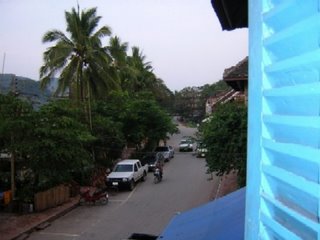
On the left, is the view from my room looking north; on the right, looking south. The Mekong River is just on the other side of the trees.
After we arrived, checked-in, and freshened up, we strolled about the town. I snapped pictures of the local children and various street scenes.

Boys planning some mischief.
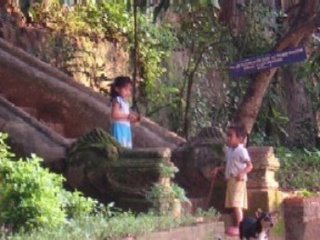
Brother, sister, and dog playing on the stairs leading to the wat (temple).

Same stairs, different view, different little
girl. Note the monk climbing the stairs.

We came across racks of sticky rice cakes drizzled with honey, drying in the sun, and shortly after the racks, the “factory” where these women were making the cakes and cooking

them in a huge pot over an open fire. The cakes are dried out before boiling. They smelled quite delicious.
The next morning, we rose early to witness oneof the traditional activities in the town, and a major tourist attraction, the procession of the monks shortly after sunrise to receive their daily foodfrom the good people of Luang Prabang. I admit it felt very odd photographing this event – the monks were the tourist attraction – but as you can see – this is what all the tourists do – this is our part.

The monks
walk through the town, the people feed the monks,
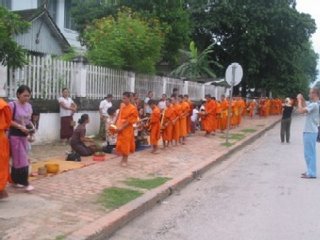
and the tourists snap pictures. It’s quite strange.

But that is part of
a green or eco tourism proposition. The worry of course is that other aspects of the local tourist industry
(the restaurants, guesthouses, treks, etc.) will overwhelm the traditional lifestyles and crowd the local townspeople out (or they will prosper so that they will develop suburbs and leave) – and then there will be no one left to feed the monks and of course, they will have to relocate their temple. And then one of the main attractions that draw tourists to the area will be gone.
I have mixed feelings about the monks and this ritual. At first, watching them as they walked through town, I thought – and what do they give back to this community which provides them with food? My traveling companion asked me to look closely at the monks and take note: most of them are very young. They become “monks” to receive education at the temple (and that doesn't mean they stay with the temple as adults - they are not, in that sense, beholden to the temple and their teachers. So in some ways, the community is feeding their young and their teachers – that’s the arrangement. But there is someone, a particular group of young people, missing in these pictures of young monks who are being educated and feed by their community: there are no girls. There are no young women or girls fostered by their community and educated in the temple. I grapple with this. I resent this. And I resent that I am considered, in this Buddhist tradition, as unclean and unchaste – and thus, I am admonished not to touch a monk – nor can any woman – yet the monk can receive his daily ration of food from such an unclean, unchaste hand. It’s a conundrum for me. For I wish to understand and respect this point of view, but I detest it as well.
Don’t be misled – I was not an ugly American. I respected the local traditions, refrained from touching monks, and made my critical comments only to my traveling companions.
While staying in Luang Prabang we took what in Thai is called a song dtang, which is essentially a small Izuzu pickup truck with two (song) benches in the back covered by a canopy, to a village outside the town. The village has a thriving silk dying and weaving industry.

We drove down a rutty, dirt road (along the way waving at a boy and his buffalo) to the village.
We explored the village a bit, asking
permission to take
pictures.
We came across a pavillion of looms
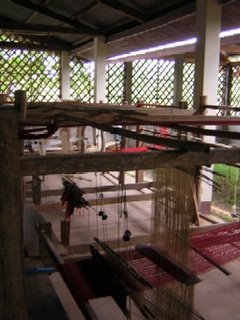
and a young woman hard at work.

And this woman is rinsing the dyed silk. This, to me, was one of the best parts of the trip - being able to go into the villages and see how these green, cottage industries operate. The women were friendly (though you can see the weaver above is concentrating quite a bit).

More to post later… this is just the tip of the iceberg.
 While in
While in 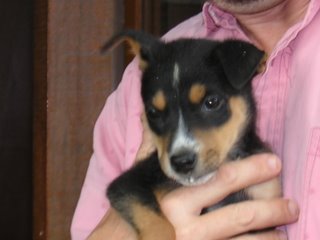 e geese. And I had company. Kitty. Kitty hung out with me. I fell in love with Kitty.
e geese. And I had company. Kitty. Kitty hung out with me. I fell in love with Kitty. 